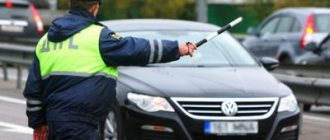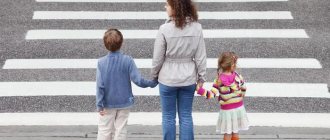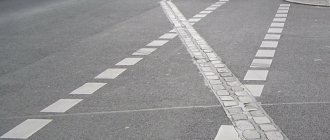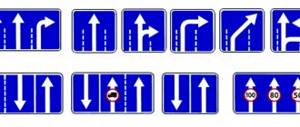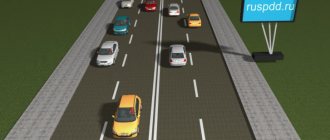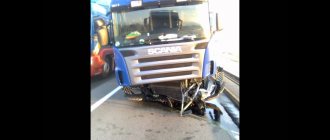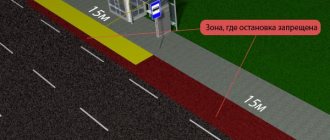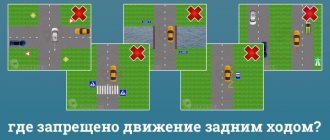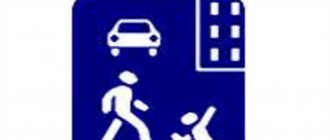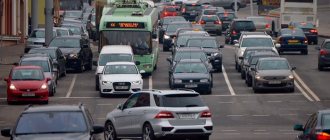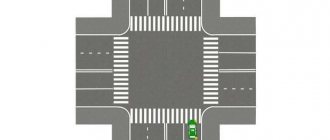Traffic rules apply not only to vehicle drivers, but also to other road users, including pedestrians. Citizens have the right to move on specially designated sidewalks, and in their absence, on the roadway. In this case, it is important which side of the road a pedestrian should walk on according to traffic rules.
Ignoring the rule about choosing which direction to drive on can lead to additional safety risks. It was to reduce the risk of accidents that the requirement on the side of movement for people without transport was introduced. A person on foot can also be brought to administrative responsibility along with other road users.
Attention! If you have any questions, you can chat for free with a lawyer at the bottom of the screen or call Moscow; Saint Petersburg; Free call for all of Russia.
Who is a pedestrian according to traffic regulations?
Traffic rules contain the rights and responsibilities of pedestrians. The definition of the concept is specified in paragraph 1.2 of the Traffic Regulations, among other terms.
Thus, the concept of pedestrian is understood as an individual who participates in movement and is a full member of the road traffic without the use of mechanical transport.
These include:
- persons who move on foot, without using any additional means of transportation;
- citizens using a wheelchair;
- moving with the help of rollers, skis or other sports equipment;
- having a bicycle or other vehicle that rolls nearby.
The legislator also introduced some concepts that directly relate to this category:
- A pedestrian path is a specially designated section of the road on which pedestrians can only move independently, without the use of vehicles. There is also a bicycle and pedestrian path on which you can also drive vehicles, such as bicycles, roller skates, and so on.
- The pedestrian zone is a separate area that is specially allocated for citizens. It differs from a path in that it is a wider area for pedestrians, in which you can only move independently.
- A pedestrian crossing is an area marked with special markings and a sign that is used for individuals to cross the road. That is, this is a special zone through which you can cross from one side of the road to the other.
The responsibilities of pedestrians are separately specified in the text of the traffic rules (Chapter 4). The main points include:
- the movement of pedestrians in specially designated areas, such as sidewalks, pedestrian paths, and if they are absent, then along the side of the road;
- a person has the right to roll a vehicle (for example, a moped or a bicycle) if it does not interfere with the movement of other vehicles;
- if there is no pedestrian zone, you can walk along the bicycle path or along the edge of the roadway;
- movement is carried out towards passing traffic, not counting some exceptions to this rule;
- if a person rolls a vehicle, he must do it on the right side, that is, in the direction of the cars;
- at night, people must ensure visibility, for example, through lighting or reflectors;
- taking into account signs and traffic lights is mandatory.
It turns out that a person must move, ensuring maximum visibility. If it is possible not to go out onto the roadway, then he should not do so.
Who is a pedestrian?
A pedestrian is a road user who, when moving, does not drive a vehicle or perform work on it. Pedestrians include disabled people in wheelchairs without a mechanical motor, owners of bicycles or mopeds who move them along the road.
In a word, a pedestrian is a person who walks on the roadway. According to the law, he is allowed to move on pedestrian paths, sidewalks or on the side of the road towards vehicle traffic if the first two options are not available.
Rules for pedestrian movement on the roadway
If there is such a possibility, the pedestrian must walk along the sidewalk, pedestrian zone or other area intended for pedestrian movement (clause 4.1 of the traffic rules). However, this is not always possible to realize. In some places there are simply no special parts where a person could walk without interfering with other people on the road, but the need to move along this particular trajectory may remain.
Traffic regulations also take this point into account, introducing rules for movement specifically on the roadway, that is, where cars and other mechanical vehicles usually drive:
- The same paragraph 4.1 of the traffic rules states that if there is no special place for people on foot, then they can move along the side of the road, that is, from the edge of the road, behind the markings, where vehicles no longer pass.
- If there is no shoulder, then the person simply moves along the edge of the road.
- The pedestrian must walk towards the traffic.
- If a person rolls, for example, a bicycle or moped, he can move in the direction of traffic. This rule also applies to those who use a wheelchair.
A person undoubtedly has the right to walk along the road, but the main requirement is that he does not interfere with passing cars through his actions. The current restrictions are in place to ensure maximum safety.
When is a pedestrian allowed to walk on the road?
A pedestrian may walk along the edge of the roadway if:
- He uses a wheelchair and interferes with other pedestrians;
- or carries things that disturb other pedestrians;
- the road is not equipped with a sidewalk, shoulder or path for pedestrians.
Pedestrians carrying or carrying bulky objects, as well as persons using non-motorized wheelchairs, may walk along the edge of the roadway if their movement on sidewalks or shoulders creates an obstacle for other pedestrians. If there are no sidewalks, pedestrian paths, bicycle paths or shoulders, and also if it is impossible to move along them, pedestrians can... walk in a single row along the edge of the roadway (on roads with a dividing strip - along the outer edge of the roadway).
Paragraph 1-2 clause 4.1
On which side of the road you need to walk according to the rules, see the table:
| Which side? | Who? |
| On the right (along the direction of the car) | Disabled people in wheelchairs; Pedestrians with a bicycle/motorcycle in their hands; Organized columns of pedestrians |
| On the left (towards the car) | Other. |
When walking along the edge of the roadway, pedestrians must walk towards the movement of vehicles. Persons moving in wheelchairs without a motor, driving a motorcycle, moped, or bicycle, in these cases must follow the direction of travel of the vehicles.
Paragraph 3 clause 4.1
Pedestrian traffic at night
The main goal of traffic rules is to establish rules that would ensure maximum safety for each participant. Driving at night is a special issue, since in conditions of reduced visibility the likelihood of accidents increases significantly.
With good street lighting, this problem is not so acute. But it is not always available even within populated areas, not to mention other territories.
In paragraph 4.1 of the traffic rules there are special provisions regarding the side of the road and requirements for people who go out onto the roadway at night:
- in populated areas, people are recommended to have reflectors with them if they move along the roadway, including when crossing the road;
- Outside populated areas, citizens are required to have reflectors.
- If there is no curb or sidewalk, the pedestrian must walk on the side of the road towards traffic.
If a pedestrian does not have a reflective element, but it is necessary to cross the road, it is recommended to use some kind of light source, for example, a flashlight on a mobile phone. It will attract the driver's attention and help avoid an accident.
Driving schoolhome traffic rules online
We have launched free distance learning on Youtube. Subscribe to our channel and watch video lectures.
4.1.
Pedestrians must move on sidewalks, pedestrian paths, bicycle and pedestrian paths, and if there are none, along the roadsides. Pedestrians carrying or carrying bulky objects, as well as persons using non-motorized wheelchairs, may walk along the edge of the roadway if their movement on sidewalks or shoulders creates an obstacle for other pedestrians.
If there are no sidewalks, pedestrian paths, bicycle paths or shoulders, and also if it is impossible to move along them, pedestrians can move along a bicycle path or walk in one row along the edge of the roadway (on roads with a dividing strip - along the outer edge of the roadway).
When walking along the edge of the roadway, pedestrians must walk towards the movement of vehicles. Persons moving in wheelchairs without a motor, driving a motorcycle, moped, or bicycle, in these cases must follow the direction of travel of the vehicles.
When crossing the road and driving along the sides or edge of the roadway in the dark or in conditions of insufficient visibility, pedestrians are recommended, and outside populated areas, pedestrians are required to carry objects with reflective elements and ensure that these objects are visible to vehicle drivers.
4.2.
The movement of organized pedestrian columns along the roadway is permitted only in the direction of movement of vehicles on the right side of no more than four people in a row. In front and behind the column on the left side there should be escorts with red flags, and in the dark and in conditions of poor visibility - with lights on: in front - white, in back - red.
Groups of children are allowed to drive only on sidewalks and pedestrian paths, and in their absence, along the roadsides, but only during daylight hours and only when accompanied by adults.
4.3.
Pedestrians must cross the road at pedestrian crossings, including underground and overground ones, and in their absence, at intersections along sidewalks or curbs.
At a controlled intersection, it is allowed to cross the roadway between opposite corners of the intersection (diagonally) only if there are markings 1.14.1 or 1.14.2 indicating such a pedestrian crossing.
If there is no crossing or intersection in the visibility zone, it is allowed to cross the road at right angles to the edge of the roadway in areas without a dividing strip and fences where it is clearly visible in both directions.
4.4.
In places where traffic is regulated, pedestrians must be guided by the signals of a traffic controller or a pedestrian traffic light, and in its absence, a transport traffic light.
4.5.
At unregulated pedestrian crossings, pedestrians can enter the roadway (tram tracks) after assessing the distance to approaching vehicles, their speed and making sure that the crossing will be safe for them. When crossing the road outside a pedestrian crossing, pedestrians, in addition, must not interfere with the movement of vehicles and exit from behind a standing vehicle or other obstacle that limits visibility without making sure that there are no approaching vehicles.
4.6.
Once on the roadway (tram tracks), pedestrians should not linger or stop unless this is related to ensuring traffic safety. Pedestrians who do not have time to complete the crossing must stop on a traffic island or on a line dividing traffic flows in opposite directions. You can continue crossing only after making sure that further movement is safe and taking into account the traffic light signal (traffic controller).
4.7.
When approaching vehicles with a blue flashing light (blue and red) and a special sound signal on, pedestrians are required to refrain from crossing the road, and pedestrians on the roadway (tram tracks) must immediately vacate the roadway (tram tracks).
4.8.
It is allowed to wait for a route vehicle and a taxi only on landing platforms raised above the roadway, and if there are none, on the sidewalk or side of the road. In stopping places for route vehicles that are not equipped with raised landing platforms, it is allowed to enter the roadway to board the vehicle only after it has stopped. After disembarking, it is necessary to clear the roadway without delay.
When moving across the roadway to or from the stopping point of a route vehicle, pedestrians must be guided by the requirements of paragraphs 4.4 - 4.7 of the Rules.
Rules for the movement of a disabled pedestrian on the roadway
Special requirements are presented for disabled people who use special wheelchairs.
On the one hand, citizens with disabilities are forced to move in a wheelchair and have no other option. On the other hand, they use a mechanism that fits the description of the vehicle. Thus, in the general provisions of the traffic rules, the concept of a vehicle is given, which is understood as a device used for transporting goods and people.
On the other hand, paragraph 1.2 of the traffic rules defines the concept of “pedestrian” and disabled people in wheelchairs are also included in this category of traffic participants.
It turns out that in general, general rules that apply to pedestrians in general apply to citizens with disabilities. But there are still some features, they are directly indicated in the traffic rules:
- the first paragraph of clause 4.1 of the traffic rules states that even if there is a sidewalk or other area for people, citizens who use wheelchairs have the right to move along the edge of the roadway;
- the third paragraph states that people usually walk towards traffic, but people in wheelchairs must move in the direction of traffic (when traveling on the road).
There are no special features for disabled people who move without wheelchairs. They participate in road traffic along with other pedestrians and, if there is no shoulder, are required to move on the left side of the road against traffic.
How to cross the road correctly?
To cross the roadway there are ground, underground and overpasses. These are the safest methods for humans. By the way, bicycle owners must cross the road on foot. But unfortunately, crossings are not available everywhere; if they are absent, a pedestrian road user can cross the roadway at an intersection along the sidewalk lines or the side of the road.
If all of the above conditions are absent, then you can cross the roadway at a right angle in an area where there are no fences or an approaching vehicle. But you need to remember about your own safety; in the dark or in poor visibility conditions, it is advisable to have reflective elements on your clothes. Despite the fact that this is a rule, there are no penalties for violation of it by law.
At a pedestrian crossing, it is also important to take care of your own safety. Before crossing the road, you need to make sure that the traffic will be safe and that there is no approaching vehicle. Because, despite the fact that the driver is obliged to let the pedestrian pass, he may not have time to brake.
Which side should a pedestrian walk on the sidewalk?
Traffic regulations establish rules of movement for pedestrians and clearly define that a pedestrian must walk along the road against traffic, that is, on the left side. However, traffic regulations do not contain requirements for the movement of people on sidewalks.
Outside the roadway, citizens can move on any side. There are also no special requirements regarding sidewalks.
If there is a bike path but no sidewalk, a pedestrian can walk along it, but there are also limitations. There is no direct indication regarding the direction of movement, but pedestrians should not interfere with bicycles; accordingly, they move from the edge.
Rights and responsibilities of a pedestrian
The rights and responsibilities of pedestrians are outlined in Chapter 4 of the Traffic Regulations. Among the main points are the following:
- Pedestrian movement is carried out in specially designated areas. You should only go out onto the roadway if they are not there.
- If there is no other option, then you can move along the edge of the road, in the direction of traffic.
- At night, a person should ensure maximum visibility using reflectors. In populated areas this is a recommendation, but outside of them it is a requirement.
- Foot columns are always directed in the direction of travel . More than 4 people are not allowed in one row. There should be guides with red flags on the front and back. In case of poor visibility, they must use lights, white in front and red in back (Section 4.2 of the Traffic Regulations).
- Crossing the road is carried out at traffic lights and special crossings, and when they are absent, at intersections (clause 4.3 of the traffic rules).
- In regulated areas, people must obey general requirements (clause 4.4 of the traffic rules).
- Before crossing the road, pedestrians must make sure that the maneuver is safe (clause 4.5 of the traffic rules).
- You cannot stop while crossing unless it is related to safety (Section 4.6 of the Traffic Regulations).
- Citizens must also let cars with special signals pass. If they are already on the road, they must clear it as quickly as possible (clause 4.7 of the traffic rules).
- You can wait for transport at special areas, and if they are not available, on the sidewalks (Section 4.8 of the Traffic Regulations).
Pedestrians have the same rights as other road users. Among the special rights, one can highlight the advantage at special crossings, sidewalks, as well as with an appropriate traffic light signal.
Life safety, 8th grade. Responsibilities of pedestrians and passengers
Fundamentals of life safety. 8th grade
Topic: Traffic management. Responsibilities of pedestrians and passengers
Time: 1 hour
Method of conducting: verbal, reproductive, problem-search.
Lesson type: combined.
Forms of organizing educational activities: individual, group.
Teaching methods: explanatory and illustrative.
Literature: Textbook: Fundamentals of life safety. 8th grade. textbook for general education institutions. Smirnov Anatoly Tikhonovich, Litvinov Evgeny Nikolaevich, Frolov Mikhail Petrovich. Publishing house AST. M, 2012
Lesson objectives:
- Learn the responsibilities of pedestrians and passengers
- Develop the need to comply with traffic rules;
- To educate a disciplined pedestrian and passenger.
Study questions:
1. Responsibilities of pedestrians
2. Responsibilities of passengers.
3. Personal safety in public transport.
During the classes:
1.A short survey on the previous topic.
2. Presentation and brief recording of lesson materials.
1. Responsibilities of pedestrians
You and I are all pedestrians as soon as we learned to walk on our feet. Our parents have been introducing us to traffic rules since childhood. At school, the responsibilities of pedestrians are explained to us, but, unfortunately, not everyone fulfills them, and over time they simply ignore them. But when a pedestrian becomes a driver, the duties of pedestrians are immediately remembered and drivers complain about undisciplined pedestrians and remind them of the duties of pedestrians.
4.1. Pedestrians must move on sidewalks or pedestrian paths, or, if there are none, along the roadsides. Pedestrians carrying or carrying bulky objects, as well as persons using non-motorized wheelchairs, may walk along the edge of the roadway if their movement on sidewalks or shoulders creates an obstacle for other pedestrians.
If there are no sidewalks, pedestrian paths or shoulders, or if it is impossible to move along them, pedestrians may move along a bicycle path or walk in a single file along the edge of the roadway (on roads with a dividing strip, along the outer edge of the roadway).
When walking along the edge of the roadway, pedestrians must walk towards the movement of vehicles. Persons moving in wheelchairs without a motor, driving a motorcycle, moped, or bicycle, in these cases must follow the direction of travel of the vehicles.
When driving along the side of the road or the edge of the roadway in the dark or in conditions of insufficient visibility, pedestrians are recommended to carry objects with reflective elements and ensure that these objects are visible to vehicle drivers.
Traffic rules are written not only for drivers. For every road user there is one or another rule of behavior on the road. This also applies to pedestrians.
The pedestrian must strictly comply with the requirements of this section. By the way, when leaving the wheel, the driver also becomes a pedestrian.
And now about where pedestrians have the right to move on the road:
— The sidewalk is clear to everyone; it is one of the elements of the road.
— A pedestrian path is a part of the road, most often parallel to the roadway and marked with sign 4.5.
— The shoulder is also part of the road, often outside the city, and can be used by both pedestrians and drivers (for example, for stopping and parking).
- Bicycle path - intended for cyclists, but in the absence of a sidewalk, shoulder or pedestrian path, you can also move along it on foot.
— The roadway is the domain of cars; in the cases described in the second paragraph of clause 4.1, the pedestrian may enter the roadway. In this case, outside the city you need to walk on the left side of the road, that is, towards cars. Pedestrians “driving” something along the roadway must move only in the same direction.
4.2. The movement of organized pedestrian columns along the roadway is permitted only in the direction of movement of vehicles on the right side of no more than four people in a row. In front and behind the column on the left side there should be escorts with red flags, and in the dark and in conditions of poor visibility - with lights on: in front - white, in back - red.
Groups of children are allowed to drive only on sidewalks and pedestrian paths, and in their absence, along the roadsides, but only during daylight hours and only when accompanied by adults.
4.3. Pedestrians must cross the roadway at pedestrian crossings, including underground and overground ones, and in their absence, at intersections along sidewalks or curbs.
If there is no crossing or intersection in the visibility zone, it is allowed to cross the road at right angles to the edge of the roadway in areas without a dividing strip and fences where it is clearly visible in both directions.
Look carefully at the pictures that show the permitted options for crossing the road and think about whether you are crossing the road correctly. (Slide No. 10)
4.4. In places where traffic is regulated, pedestrians must be guided by the signals of a traffic controller or a pedestrian traffic light, and in its absence, a transport traffic light.
Civilized people watch traffic lights and do not cross the road in front of approaching traffic! After all, “saving” 30–40 seconds (that’s how long you need to wait for the traffic lights to change) often leads to tragic consequences.
Isn't it time to ask yourself one important question: continue to fuss, run across the road at a prohibiting traffic light and constantly risk your life, or, finally, join the civilized part of the population that respects the laws?
4.5. At unregulated pedestrian crossings, pedestrians can enter the roadway after assessing the distance to approaching vehicles, their speed and making sure that the crossing will be safe for them. When crossing a roadway outside a pedestrian crossing, pedestrians must, in addition, not interfere with the movement of vehicles and exit from behind a standing vehicle or other obstacle that limits visibility without making sure that there are no approaching vehicles.
From the figure “Dead” zone (Slide No. 11), it follows:
that not only a bus standing at a stop, but also other objects located on the road or in its immediate vicinity can create a “dead” uninspected zone.
When the car is moving, the view of the road perspective is often limited. In such cases, you must be prepared for the fact that someone who has not read this book may suddenly appear from the “dead” zone. I believe that a pedestrian who has read this page will no longer want to repeat the feat of the “heroes” depicted in these pictures.
Well, as a pedestrian, you will now be more attentive and respectful towards drivers.
4.6. Once on the roadway, pedestrians should not linger or stop unless this is related to ensuring traffic safety. Pedestrians who do not have time to complete the crossing must stop on the line dividing traffic flows in opposite directions. You can continue crossing only after making sure that further movement is safe and taking into account the traffic light signal (traffic controller).
4.7. When approaching vehicles with a blue flashing light (blue and red) and a special sound signal on, pedestrians are required to refrain from crossing the roadway, and pedestrians on it must immediately vacate the roadway. (Slide No. 11)
4.8. Waiting for a route vehicle and a taxi is allowed only on landing platforms raised above the roadway, and if there are none, on the sidewalk or side of the road. In stopping places for route vehicles that are not equipped with raised landing platforms, it is allowed to enter the roadway to board the vehicle only after it has stopped. After disembarking, it is necessary to clear the roadway without delay.
When moving across the roadway to or from the stopping point of a route vehicle, pedestrians must be guided by the requirements of paragraphs 4.4-4.7 of the Rules.
Paragraph 4.8 discusses the rules of conduct for a pedestrian passenger depending on the presence of a landing pad or the absence of a landing pad at a tram stop in the middle of the road (Slides No. 12-13):
1. The landing site is located on a dividing strip raised above the roadway; in this case, you must wait for the tram at the landing site. And you can get there only in compliance with the requirements of paragraphs 4.4-4.7 of the traffic rules , that is, without interfering with traffic moving along the road.
2. There is no landing pad. Pedestrians must wait for the tram on the sidewalk .
After waiting for the tram to come to a complete stop, pedestrians have the right to exit onto the roadway and begin boarding.
Drivers of vehicles in this situation are required to give way to passengers who exit the tram, enter it, and also cross the roadway from the sidewalk to the tram and from the tram to the sidewalk.
In a big city (hustle and nerves), you can notice the impatience of pedestrians entering the roadway before the tram reaches its stop, as well as drivers trying to pass by a tram whose boarding and disembarking has not yet finished.
And if you think about those 20-30 seconds that are needed to comply with simple traffic rules? On one side of the scale are seconds, and on the other are pretty frayed nerves. Do I need to add anything?
2. Responsibilities of passengers
5.1 Passengers are obliged to:
· When traveling in a vehicle equipped with seat belts, be wearing them, and when riding a motorcycle, wear a fastened motorcycle helmet;
· Boarding and disembarking should be done from the sidewalk or curb and only after the vehicle has come to a complete stop.
If boarding and alighting is not possible from the sidewalk or curb, it may be carried out from the roadway, provided that it is safe and does not interfere with other road users.
5.2 Passengers are prohibited from:
· distract the driver from driving the vehicle while it is moving;
· when traveling on a truck with a flatbed, stand, sit on the sides or the load above the sides;
· open the doors of the vehicle while it is moving.
3. HOW TO ENSURE PERSONAL SAFETY WHEN DRIVING IN PUBLIC TRANSPORT
When on public transport, if there are no free seats, try to stand in the center of the cabin, holding on to the handrail for greater stability. Pay attention to the location of emergency and emergency exits.
Electric power supply of trams and trolleybuses creates an additional threat of electric shock to a person (especially in rainy weather), so seated areas are the safest. If you find that the interior is under voltage, leave it. In case of an accident, panic and crush may occur at the exits. In this case, use the emergency exit by pulling out the special cord and pushing out the glass.
In the event of a fire in the cabin, notify the driver, open the doors (using emergency opening), emergency exits or break a window. If there is a fire extinguisher in the cabin, take measures to eliminate the fire. Protect your respiratory system from smoke with a scarf, handkerchief or other items of clothing. Get out of the cabin, bending down and not touching metal parts, as in a tram and trolleybus you may be electrocuted.
If a bus falls into water, wait until the passenger compartment is half filled with water, hold your breath and emerge through a door, emergency exit or broken window.
Conclusion: Consolidation of the material covered.
Homework: 1. Study §2.2 of the textbook;
2. Lesson summary.
Penalty for driving incorrectly on the roadway
Administrative liability is provided not only for violation of traffic rules by drivers, but also applies to pedestrians. Thus, the Code of Administrative Offenses of the Russian Federation presents a number of norms for violation of which citizens are held accountable:
| Violation | Article of the Code of Administrative Offenses of the Russian Federation | Sanction |
| Violation of traffic rules by a pedestrian or passenger. An ordinary violation is assumed, which does not entail significant consequences in the form of additional damage to any traffic participant. It is also important that such a violation does not create interference for others, for example, it could be jaywalking when there is no vehicle nearby or driving on the wrong side of the road. | Part 1 art. 12.29 | Warning or fine of 500 rubles |
| Violation of traffic rules under the condition of interfering with transport. Here the pedestrian interferes with other traffic participants, for example, a passing car, if he ignores the traffic light signal. | Part 1 art. 12.30 | Fine 1000 rubles |
| Violation of traffic rules by a passenger, resulting in minor or moderate harm to health. In case of serious harm, criminal liability is already provided. | Part 2 art. 12.30 | Fine 1500 rubles |
All violations by pedestrians, including jaywalking and other common violations, are punishable in accordance with these articles.
Who is at fault in an accident with a pedestrian?
A fine is not the only type of liability that a pedestrian bears if he is at fault. However, in practice, situations where a person moving independently will be at fault are quite rare.
Thus, in accordance with paragraph 8.1 of the traffic rules, the driver must ensure the safety of his maneuver, as well as inform other road users about the actions being taken (for example, using a turn signal).
If a driver hits a person at a crossing, then it will not be possible to avoid liability. The blame falls entirely on whoever was driving, since pedestrians have the right of way in such areas.
A similar situation arises if the accident occurred on the sidewalk or roadside (provided there is no sidewalk). In these places, the pedestrian also has an advantage if he walked on the right side of the road and did not violate any other rules.
The situation becomes more complicated when an accident occurs outside pedestrian zones, that is, on the roadway. There is an opinion that even in this case the driver will bear full responsibility, but this is not always the case.
A citizen driving a car or other transport will be held liable in the following situations:
- he had the opportunity to avoid a collision;
- the lighting was sufficient, the person appeared on the road in advance;
- the accident occurred due to a malfunction of his vehicle;
- the driver was intoxicated.
Innocence can be proven by referring to poor lighting, the fact that the person appeared on the side of the road unexpectedly and did not have reflective elements in the dark. In this case, you can use the testimony of registrars and witnesses.
Crossing the roadway
If you believe the statistics, then the joint compliance of all road users with the prescribed norms and legal requirements minimizes the risk of accidents. To summarize, it can be noted that a pedestrian is obliged to move strictly on the territory intended for him: a special lane, sidewalk or path. Only when such places are not allocated is it allowed to move on the right side of the road.
These rules are not difficult to remember, but their implementation guarantees safety on the road. The basic norms that regulate the behavior of pedestrians on the road include a whole list of provisions: it would be much more effective to evaluate each case separately and refer to certain points each time.
On the sidewalk
The sidewalk is usually perceived as a separate part of the road, which is designated specifically for pedestrians. Often it is additionally separated by a curb, fence or lawn: you can move there in any direction absolutely unhindered. But it is important to remember that the sidewalk and the curb are not the same thing.
The second walking zone is also considered part of the road, but is not marked out in any way and does not have clear boundaries with the roadway area. If there is no sidewalk, the pedestrian can walk along the side of the road in the direction he needs. At the same time, any person has the right to move along the edge of the road if there is no safer option within sight. Although the pedestrian must still walk strictly on the side of oncoming traffic.
Along the pedestrian path
Initially, a pedestrian path is presented as a structure located outside the route, which is necessary for walking outside or inside a populated area, highlighted with the help of sign 4.5.1.
This designation is located directly in front of the road, where the default limit for cars is introduced. But its action continues immediately after the place of fixation. In fact, only sign 4.5.2 “End of the pedestrian path” cancels this ban.
Sometimes the surface of an artificial structure is used as this area, but more often it is just a fragment of the earth’s surface near the central road. You should also distinguish between a sidewalk and a path for pedestrians: the latter is intended for those who walk and is marked with a special sign.
Along the bike path
In principle, you should not confuse a bicycle pedestrian path with its regular bicycle counterpart. Since the first is necessary simultaneously for the movement of both cyclists and pedestrians, while the second is exclusively for cyclists. It is also quite easy to distinguish them: a bicycle path is marked with sign 4.4.1, and a mixed path with a pedestrian function is marked with signs 4.5.2 - 4.5.7.
The first thing to remember is that pedestrians are only allowed to walk on a bicycle path in a situation where there is no sidewalk, shoulder or separate path for pedestrians. Even those people who drive (or use) wheelchairs, strollers or roller skates cannot be on bicycle paths if there is a sidewalk - this is very dangerous.
Along the side of the roadway
Theoretically, a pedestrian must constantly remain on the sidewalk, pedestrian zone or other area specially designated for this type of movement (clause 4.1 of the traffic rules). But in reality, such a scheme is rarely implemented. Sometimes there are no areas at all where a citizen has the right to walk freely without disturbing others. Therefore, special provisions have been additionally introduced for movement specifically on the roadway (where cars usually drive):
- If there is no zone for pedestrians, you need to walk along the side of the road (along the edge of the road, behind the markings, where there are no cars).
- If there is also no shoulder, other people have the opportunity to move at their usual pace simply along the roadway.
- If a person is rolling a bicycle or moped, he can follow the same flow (the rule is duplicated for people with disabilities).
Summarizing all the recommendations, a citizen should walk along the road without any special obstacles, but the main requirement here is not to create additional problems with his trajectory for other passing cars and drivers.
For invalids
Persons with limited physical capabilities, who are unable to fully walk, but are forced to move on wheelchairs without a motor, are allowed to move along the edge of the road. Similar rights are simultaneously granted to those people who transport large objects on two-wheeled vehicles or who carry large objects or things in their hands.
Hypothetically, this is by no means a mandatory requirement, but only a backup option for unloading difficult traffic on the sidewalk. But if they wish, all the mentioned persons with oversized cargo can move along the sidewalk, and this will not constitute a violation.
In the yard area
A separate category is worth considering such places as areas in courtyards and residential areas - this is where almost everyone can walk along the roadway. But this is not considered an endorsement for any self-will: even then, drivers are required to yield to pedestrians.
However, the latter persons, without special reasons, should not deliberately interfere with the movement of vehicles. So, if, while walking through the yard, you suddenly need to stop, then you need to perform this maneuver on the sidewalk, and not on the path where cars pass. But the law imposes significant restrictions on car owners regarding movement and stopping in the territory of any courtyards.
Crossing controlled and unregulated intersections
Section 4 of the traffic rules quite clearly stipulates that all pedestrians are allowed to cross the road only in strictly designated areas, according to painted markings. If for some reason there are no such signs, then at intersections you must move along the curb and sidewalk. When the intersection is regulated (there is a traffic light or a traffic controller is present), you can move to:
- green signal of a special traffic light for pedestrians;
- red traffic light for vehicles.
Remember that flashing yellow traffic lights at intersections do not regulate traffic, but only warn drivers of danger. And to cross the highway in such places, you should rely on the requirements of traffic on unregulated crossings.
Pedestrians at an uncontrolled intersection and crossing, in fact, are always independently responsible for their own safety: they estimate the length of the distance to the approaching car, determine its speed and, based on this, decide whether it is safe to cross the road or not. Thus, in case of violation of the above norms, citizens bear full responsibility for creating an emergency situation.
No pedestrian crossing
Even in paragraph 4.3 of the traffic rules for 2021, it is described in detail exactly what a pedestrian should do when crossing the road at an intersection, in the absence of a pedestrian crossing. He is obliged to cross the roadway along the sidewalks or curbs. It is also important to note that in the set of conditions there is not a word that the lines of sidewalks or curbs there are equated to pedestrian crossings.
If we refer to paragraph 4.5., then at unregulated pedestrian crossings people have the right to go out onto the roadway (tram tracks) after assessing the situation on the road.
Here, unlike crossing the road at a pedestrian crossing, in addition to the need to make sure that the crossing is safe, the rules oblige each pedestrian not to interfere with other traffic participants. Therefore, it is not entirely clear what exactly some people are guided by when they equate the lines of sidewalks or roadsides to a pedestrian crossing.
Driving on the road in the dark
It is very characteristic that strict requirements have been specifically established regarding movement on the roadway in poor visibility, even in the evening and at night. This period usually means the time from evening twilight to morning. At the same time, insufficient visibility is also noted for viewing the roadway at a distance of less than 300 m during rain, twilight, fog and other weather anomalies.
In the case of the above conditions, pedestrians in populated areas are advised to stock up on reflective items or professional clothing. For this purpose, you can buy special vests that are used by workers on the roads (considering that they are cheap - up to 500 rubles).
When a pedestrian is outside a city or town, he must fulfill this condition so that drivers have the opportunity to notice the pedestrian and let him through in time. Very often, reflective clothing and items prevent accidents and accidents. If you don’t have reflective elements at hand, it is recommended to use a flashlight or the glow of your phone so that motorists notice you.
Nuances
When moving, people must follow a number of rules that are introduced to achieve safety. At first glance, they seem simple, but in practice they have their own characteristics:
- The law identifies wheelchair users as a special group, assigning them movement in the direction of traffic. But other disabled people do not have any special requirements; their position on the road is regulated by the general rules inherent to pedestrians.
- A citizen may also be brought to civil liability if he is found guilty as a result of registering an accident. Victims have the right to file a claim for damages in court. The amount of damage is confirmed by documents and examination.
- A pedestrian may also be held criminally liable if, as a result of his guilt, another citizen receives serious bodily injury (Article 268 of the Criminal Code of the Russian Federation).
- Organized columns move along the sides of the road according to their own rules.
- Cyclists must follow their own rules and are considered pedestrians only if they ride alongside.
- A person who violates the rules of crossing or being on the wrong side of the road may also be found guilty. But everything is considered individually.
The legislator did not provide for liability for being on the roadway and crossing a road within a populated area without reflectors, but in the event of an accident, a pedestrian on foot may be found guilty, especially in a situation where other lighting was insufficient.
